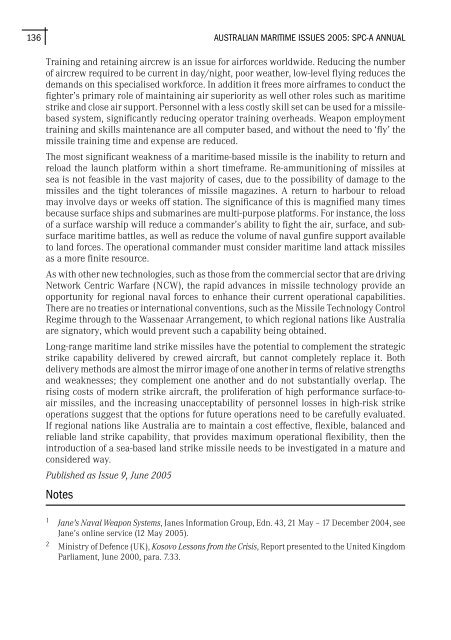Australian Maritime Issues 2005 - Royal Australian Navy
Australian Maritime Issues 2005 - Royal Australian Navy
Australian Maritime Issues 2005 - Royal Australian Navy
Create successful ePaper yourself
Turn your PDF publications into a flip-book with our unique Google optimized e-Paper software.
136<br />
AUSTRALIAN MARITIME ISSUES <strong>2005</strong>: SPC-A ANNUAL<br />
Training and retaining aircrew is an issue for airforces worldwide. Reducing the number<br />
of aircrew required to be current in day/night, poor weather, low-level flying reduces the<br />
demands on this specialised workforce. In addition it frees more airframes to conduct the<br />
fighter’s primary role of maintaining air superiority as well other roles such as maritime<br />
strike and close air support. Personnel with a less costly skill set can be used for a missilebased<br />
system, significantly reducing operator training overheads. Weapon employment<br />
training and skills maintenance are all computer based, and without the need to ‘fly’ the<br />
missile training time and expense are reduced.<br />
The most significant weakness of a maritime-based missile is the inability to return and<br />
reload the launch platform within a short timeframe. Re-ammunitioning of missiles at<br />
sea is not feasible in the vast majority of cases, due to the possibility of damage to the<br />
missiles and the tight tolerances of missile magazines. A return to harbour to reload<br />
may involve days or weeks off station. The significance of this is magnified many times<br />
because surface ships and submarines are multi-purpose platforms. For instance, the loss<br />
of a surface warship will reduce a commander’s ability to fight the air, surface, and subsurface<br />
maritime battles, as well as reduce the volume of naval gunfire support available<br />
to land forces. The operational commander must consider maritime land attack missiles<br />
as a more finite resource.<br />
As with other new technologies, such as those from the commercial sector that are driving<br />
Network Centric Warfare (NCW), the rapid advances in missile technology provide an<br />
opportunity for regional naval forces to enhance their current operational capabilities.<br />
There are no treaties or international conventions, such as the Missile Technology Control<br />
Regime through to the Wassenaar Arrangement, to which regional nations like Australia<br />
are signatory, which would prevent such a capability being obtained.<br />
Long-range maritime land strike missiles have the potential to complement the strategic<br />
strike capability delivered by crewed aircraft, but cannot completely replace it. Both<br />
delivery methods are almost the mirror image of one another in terms of relative strengths<br />
and weaknesses; they complement one another and do not substantially overlap. The<br />
rising costs of modern strike aircraft, the proliferation of high performance surface-toair<br />
missiles, and the increasing unacceptability of personnel losses in high-risk strike<br />
operations suggest that the options for future operations need to be carefully evaluated.<br />
If regional nations like Australia are to maintain a cost effective, flexible, balanced and<br />
reliable land strike capability, that provides maximum operational flexibility, then the<br />
introduction of a sea-based land strike missile needs to be investigated in a mature and<br />
considered way.<br />
Published as Issue 9, June <strong>2005</strong><br />
Notes<br />
1 Jane’s Naval Weapon Systems, Janes Information Group, Edn. 43, 21 May – 17 December 2004, see<br />
Jane’s online service (12 May <strong>2005</strong>).<br />
2 Ministry of Defence (UK), Kosovo Lessons from the Crisis, Report presented to the United Kingdom<br />
Parliament, June 2000, para. 7.33.

















